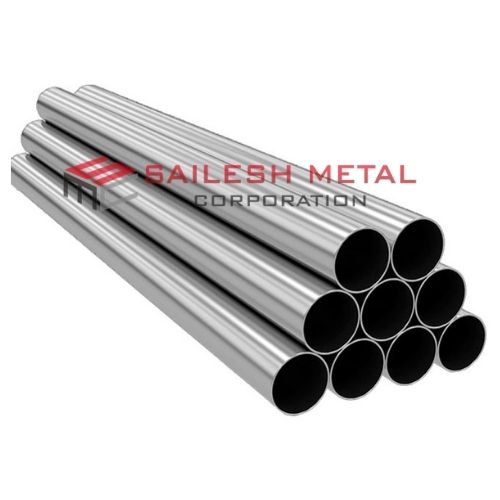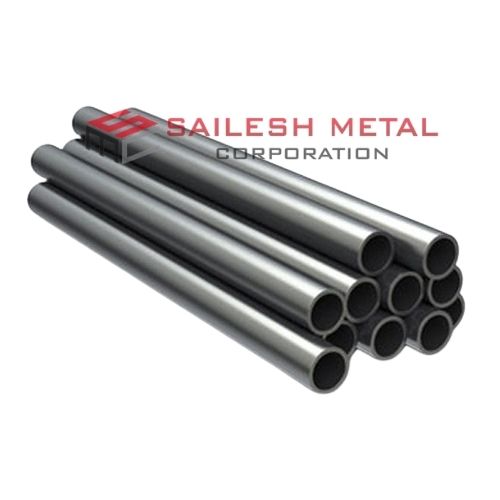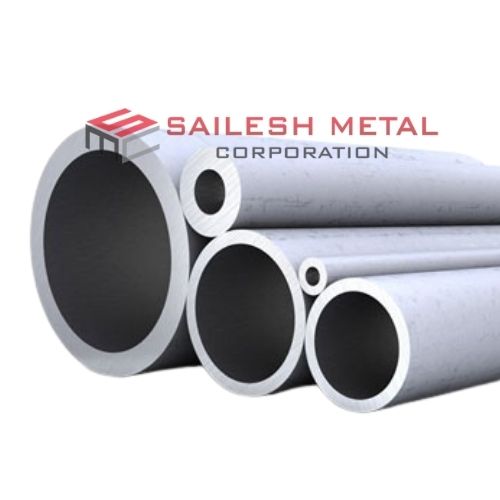VDM Alloys 276 Pipes
Supplier, Manufacturer & Distributor in India.
VDM Alloy 276 Pipes is a nickel-chrome-molybdenum alloy with tungsten supplied, manufactured & distributed by Sailesh Metal Corporation.
It is characterized by:
Extraordinary resistance across a wide range of corrosive, watery media; in particular oxidizing and reducing acids
Particularly high resistance against chloride-induced crevice, pitting and stress corrosion
VDM Alloy 276 Pipes

VDM Alloy 276 Pipes Supplier

VDM Alloy 276 Pipes Distributor

Applications of VDM Alloy 276 Pipes
VDM Alloy 276 has a broad field of application in the chemicals and petrochemicals industry, for components in organic processes containing chlorides, and for catalytic systems. The material can be used especially in cases where hot, contaminated mineral acids, solutions or organic acids (such as formic acid and acetic acid) and sea water occur.
Examples of fields of application:
Paper and pulp industry, e.g. for digestion and bleaching tanks
Washers, agitators and wet ventilators in flue gas desulfurization systems
Equipment and components for acid gas applications
Reactors for acetic acid production
Sulfuric acid coolers
Methylene diphenyl isocyanate (MDI)
Manufacturing and processing of contaminated phosphoric acid
Physical properties of VDM Alloy 276 Pipes
| Density | Melting range | Relative magnetic permeability at 20 °C (68 °F) | |||
| 8.9 g/cm3 (0.32 lb/in3) at 20 °C (68 °F) | 1,325-1,370 °C (2,417-2,498 °F) | 1,001 (Maximum) |
| Temperature | Specific heat capacity | Thermal conductivity | Electrical resistivity | Modulus of elasticity | Coefficient of thermal expansion | ||||||||||||||
|
°C |
°F |
J
Kg · K |
Btu lb ∙ °F | W
m ∙ K |
Btu ∙ in
sq. ft ∙ h ∙ °F |
μΩ · cm |
GPa |
103 ksi |
10-6
K |
10-6
°F |
|||||||||
| 20 | 68 | 426 | 0.102 | 10.2 | 70.8 | 125 | 208 | 30.2 | 12.1 | 6.72 | |||||||||
| 100 | 212 | 438 | 0.105 | 11.6 | 80.5 | 127 | 204 | 29.6 | 12.4 | 6.89 | |||||||||
| 200 | 392 | 453 | 0.108 | 13.4 | 93.0 | 128.5 | 200 | 29.0 | 12.8 | 7.11 | |||||||||
| 300 | 572 | 469 | 0.112 | 15.1 | 104.8 | 129 | 195 | 28.3 | 13.1 | 7.28 | |||||||||
| 400 | 762 | 483 | 0.115 | 16.7 | 115.9 | 129.5 | 188 | 27.3 | 13.4 | 7.44 | |||||||||
| 500 | 932 | 493 | 0.118 | 18.1 | 125.6 | 129 | 182 | 26.4 | 13.4 | 7.44 | |||||||||
| 600 | 1,112 | 515 | 0.123 | 20.2 | 140.1 | 128.5 | 175 | 25.4 | 13.5 | 7.50 | |||||||||
| 700 | 1,292 | 609 | 0.145 | 25.7 | 178.3 | 128 | 168 | 24.4 | 14.0 | 7.78 | |||||||||
| 800 | 1,472 | 605 | 0.145 | 25.8 | 179.0 | 126.5 | 160 | 23.2 | 14.6 | 8.11 | |||||||||
| 900 | 1,652 | 609 | 0.145 | 25.9 | 179.7 | 126 | 151 | 21.9 | 15.1 | 8.39 | |||||||||
| 1,000 | 1,832 | 605 | 0.145 | 27.2 | 188.7 | 125.5 | 143 | 20.7 | 15.6 | 8.67 | |||||||||
Mechanical properties of VDM Alloy 276 Pipes
The following minimum values at room and increased temperatures apply to the solution-annealed condition for longitudinal and traverse test samples of the specified dimensions. The properties for larger dimensions must be agreed upon separately.
| Temperature | Yield strength Rp 0.2 | Tensile strength Rm | ||||||||
| °C | °F | MPa | ksi | MPa | ksi | |||||
| 20 | 68 | 310 | 45.0 | 700 | 101.5 | |||||
| 100 | 212 | 280 | 40.6 | 660 | 95.7 | |||||
| 200 | 392 | 240 | 34.8 | 630 | 91.4 | |||||
| 300 | 572 | 220 | 31.9 | 600 | 87.0 | |||||
| 400 | 752 | 195 | 28.3 | 570 | 82.7 | |||||
| 450 | 842 | 150 | 21.8 | 530 | 76.9 |
Chemical composition
| Ni | Cr | Fe | C | Mn | Si | W | Mo | Co | V | P | S | |||||||||||||
| Min. | 51 | 15 | 4 | 3 | 15 | |||||||||||||||||||
| Max. | 63 | 16.5 | 7 | 0.01 | 1 | 0.08 | 4.5 | 17 | 2.5 | 0.3 | 0.02 | 0.01 | ||||||||||||
Fabrication and Heat treatment
VDM Alloy 276 Pipes is ideally suited for processing by means of common industrial processing techniques.
Heating
It is important that the workpieces are clean and free of any contaminants before and during heat treatment. Sulphur, phosphorus, lead and other low-melting-point metals can result in damage during the heat treatment of VDM Alloy 276
This type of contamination is also contained in marking and temperature-indicating paints or paints, and also in lubricating grease, oils, fuels and similar materials. Fuels must have as low a sulphur content as possible. Natural gas should contain less than 0.1% by weight of sulphur. Heating oil with a maximum sulphur content of 0.5% by weight is also suitable. Electrical furnaces are to be preferred due to precise temperature control and lack of contaminants due to fuel. The furnace temperature should be set between neutral and slightly oxidizing, and should not change between oxidizing and reducing. The workpieces may not come in direct contact with flames.
Hot forming
VDM Alloy C 276 should be hot-formed in a temperature range of 950 to 1,200 °C (1,742 to 2,192 °F) with subsequent rapid cooling in water or in air. Heat treatment after hot-working is recommended in order to achieve optimal corrosion behaviour. For heating up, workpieces should be placed in a furnace that is already heated up to the target value.
Cold forming
The workpieces should be in the annealed condition for cold working. VDM Alloy C 276 has significantly higher cold forming properties than the widely used austenitic stainless steels. This must be taken into account during design and selection of forming tools and equipment and during the planning of forming processes. Intermediate annealing is necessary for major cold-working treatment. When cold forming of > 15 %, final solution annealing must be conducted.
Heat treatment
Solution annealing should take place at temperatures of between 1,100 and 1,160 °C (2,012 and 2,120 °F). The retention time during annealing depends on the semi-finished product thickness and can be calculated as follows:
The retention time commences with material temperature equalization; longer times are generally considerably less critical than retention times that are too short.
Cooling down should be accelerated with water to achieve optimum properties. Fast air cooling can also be carried out at thicknesses of less than approx. 1.5 mm (0.059 in). In the process, the cooling must take place within 2 minutes be- tween 1,000 and 600 °C (1,832 and 1,112 °F). The material must be placed in a furnace that has been heated up to the maximum annealing temperature before any heat treatment. For strip and wire products, the heat treatment can be performed in a continuous furnace at a speed and temperature that is adapted to the material thickness. The cleanliness requirements listed in the Section ‘Heating’ have to be observed.
Descaling and pickling
Oxides of VDM Alloy 276 and discoloration adjacent to welds are more adherent than on stainless steels. Grinding using extremely fine abrasive belts or grinding discs is recommended. Care should be taken to prevent tarnishing. Before pickling in salt peter hydrofluoric acid mixtures, the oxide layers should be broken up by abrasive blasting or fine grinding, or pre-treated in in a fused salt bath. The pickling baths used should be carefully monitored with regard to concentration and temperature.
Machining
VDM Alloy 276 should be machined in the heat-treated condition. For reasons of the considerably increased tendency to work hardening in comparison to austenitic stainless steels, a low cut speed at a feed level that is not too high should be selected and the cutting tool should be engaged at all times. An adequate depth of cut is important in order to cut below the previously formed strain-hardened zone. Optimum heat dissipation through the use of large quantities of suitable, preferably aqueous, lubricants has considerable influence on a stable machining process.

